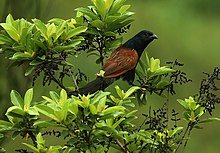Coucal
| Coucals | |
|---|---|

| |
| Lesser coucal (Centropus bengalensis) | |
| Scientific classification | |
| Domain: | Eukaryota |
| Kingdom: | Animalia |
| Phylum: | Chordata |
| Class: | Aves |
| Order: | Cuculiformes
|
| Family: | Cuculidae Horsfield, 1823 |
| Genus: | Centropus Illiger, 1811 |
| Type species | |
| Cuculus aegyptius (Senegal coucal) Linnaeus, 1766
| |
| Species | |
|
About 30, see list | |
A coucal is one of about 30
Taxonomy
The genus Centropus was introduced in 1811 by the German zoologist Johann Karl Wilhelm Illiger.[3] The type species was subsequently designated as the Senegal coucal by George Robert Gray in 1840.[4][5] The genus name combines the Ancient Greek kentron meaning "spur" or "spike" with pous meaning "foot".[6]
Description
Many coucals have a long claw on their hind toe (hallux). The feet have minute spurs and this is responsible for the German term for coucals Sporenkuckucke. The common name is perhaps derived from the French coucou and alouette (for the long lark like claw).[7] (Cuvier, in Newton 1896) The length of the claw can be about 68-76% of the tarsus length in the African black coucal C. grillii and lesser coucal C. bengalensis. Only the short-toed coucal C. rectunguis is an exception with the hallux claw of only 23% of the tarsus length. Thread like feather structures (elongated sheaths of the growing feathers that are sometimes termed trichoptiles[8][9]) are found on the head and neck of hatchlings and can be as long as 20mm. Nestlings can look spiny.[10] Many are opportunistic predators, Centropus phasianus is known to attack birds caught in mist nets[11] while white-browed coucals Centropus superciliosus are attracted to smoke from grass fires where they forage for insects and small mammals escaping from the fire.[10]: 17
Coucals generally make nests inside dense vegetation and they usually have the top covered but some species have the top open. Pheasant coucal Centropus phasianinus, greater coucal C. sinensis and Madagascar coucal C. toulou sometimes build an open nest while some species always build open nests (the bay coucal C. celebensis)[10]: 120
Some coucal species have been seen to fly while carrying their young.[12]
Species
The genus contains 29 species:[13]
- Buff-headed coucal, Centropus milo
- White-necked coucal or pied coucal, Centropus ateralbus
- Ivory-billed coucal or greater black coucal, Centropus menbeki
- Biak coucal, Centropus chalybeus
- Rufous coucal, Centropus unirufus
- Green-billed coucal, Centropus chlororhynchos
- Black-faced coucal, Centropus melanops
- Black-hooded coucal, Centropus steerii
- Short-toed coucal, Centropus rectunguis
- Bay coucal, Centropus celebensis
- Gabon coucal, Centropus anselli
- Black-throated coucal, Centropus leucogaster
- Senegal coucal, Centropus senegalensis
- Blue-headed coucal, Centropus monachus
- Coppery-tailed coucal, Centropus cupreicaudus
- White-browed coucal, Centropus superciliosus
- Burchell's coucal, Centropus burchellii
- Sunda coucal, Centropus nigrorufus
- Greater coucal, Centropus sinensis
- Malagasy coucal or Madagascar coucal, Centropus toulou
- Goliath coucal, Centropus goliath
- Black coucal, Centropus grillii
- Philippine coucal, Centropus viridis
- Lesser coucal, Centropus bengalensis
- Violaceous coucal, Centropus violaceus
- Black-billed coucal or lesser black coucal, Centropus bernsteini
- Kai coucal, Centropus spilopterus
- Pheasant coucal, Centropus phasianinus
- Andaman coucal or brown coucal, Centropus andamanensis
A fossil species, Centropus colossus, is known from the Quaternary-aged Fossil Cave, Tantanoola, South Australia.
References
- .
- doi:10.1111/j.1095-8312.1995.tb01030.x. Archived from the original(Abstract) on 2013-01-05.
- ^ Illiger, Johann Karl Wilhelm (1811). Prodromus systematis mammalium et avium (in Latin). Berolini [Berlin]: Sumptibus C. Salfeld. p. 205.
- ^ Gray, George Robert (1840). A List of the Genera of Birds : with an Indication of the Typical Species of Each Genus. London: R. and J.E. Taylor. p. 56.
- ^ Peters, James Lee, ed. (1940). Check-List of Birds of the World. Vol. 4. Cambridge, Massachusetts: Harvard University Press. p. 66.
- ISBN 978-1-4081-2501-4.
- ^ Newton, Alfred (1893–1896). A Dictionary of Birds. London: Adam and Charles Black. p. 107.
- .
- .
- ^ ISBN 0-19-850213-3.
- ^ Hicks, R.K.; Restall, R. (1992). "Pheasant coucal Centropus phasianus attacking birds caught in a mist net". Muruk. 5: 143.
- ^ Bell, H.L. (1984). "Carrying of young in flight by Coucals Centropus spp". Australian Bird Watcher. 10: 171.
- Rasmussen, Pamela, eds. (January 2022). "Turacos, bustards, cuckoos, mesites, sandgrouse". IOC World Bird List Version 12.1. International Ornithologists' Union. Retrieved 12 August 2022.
